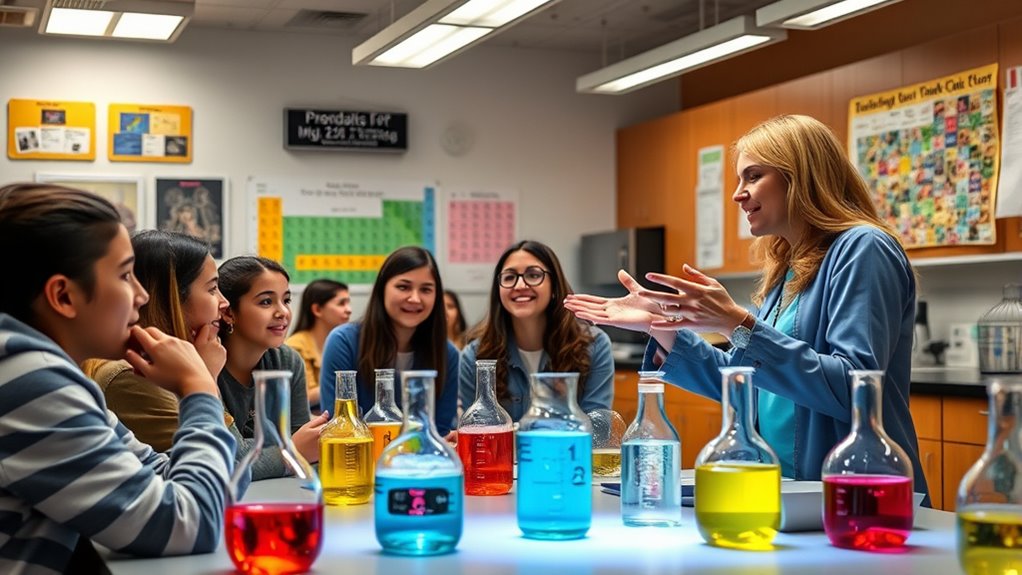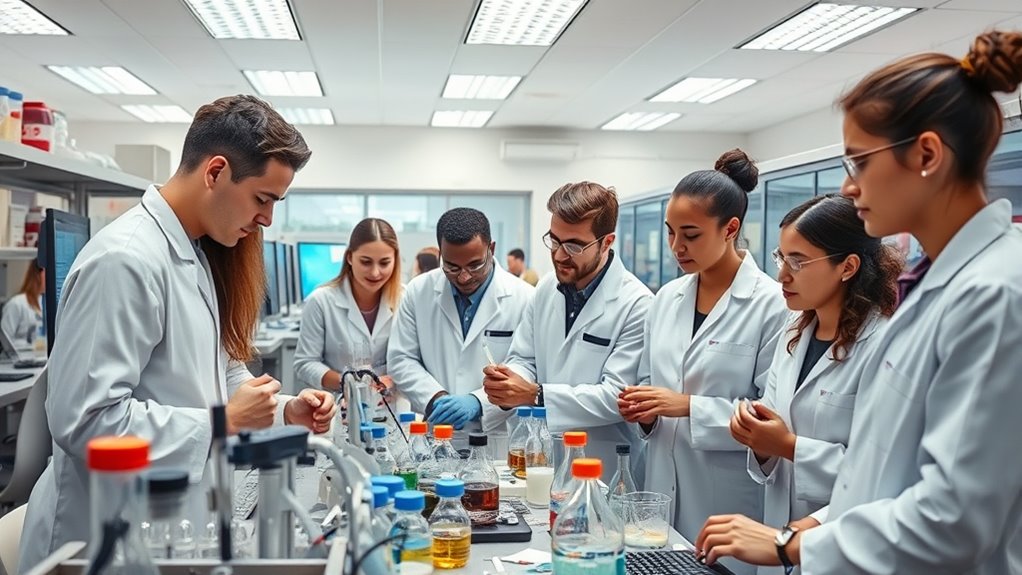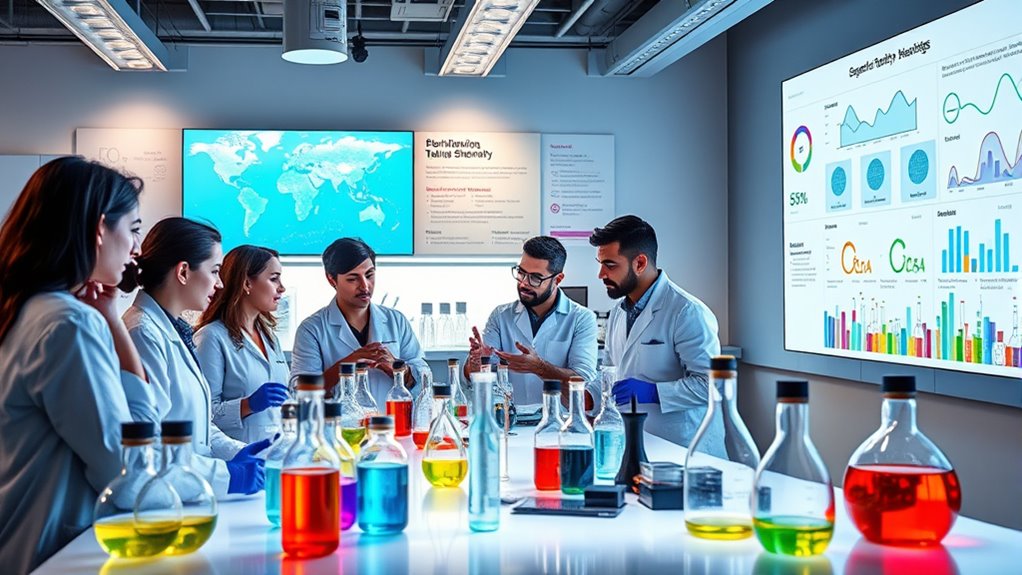To address a talent shortage in chemistry, you should expand your recruitment efforts beyond local pools, utilizing digital platforms, social media, and international job boards to find diverse candidates. Partner with educational institutions for internships and scholarships, and promote your company’s innovative culture to attract younger talent. Invest in continuous training for your team and implement mentorship programs to retain expertise. Keep exploring strategies to strengthen your workforce and stay ahead in the industry.
Key Takeaways
- Expand recruitment efforts through international platforms, virtual interviews, and targeted advertising to access diverse, global talent pools.
- Strengthen partnerships with universities via internships, scholarships, and industry collaborations to build a sustainable talent pipeline.
- Offer flexible work arrangements, career development programs, and mentorship to improve retention of experienced employees.
- Promote industry perception shifts by highlighting innovation, sustainability, and technology leadership to attract younger talent.
- Invest in continuous skills development, cross-disciplinary training, and technological upgrades to address skills gaps and future-proof the workforce.
Understanding the Root Causes of Talent Scarcity in the Chemical Sector

The talent shortage in the chemical sector stems from multiple interconnected factors that make it difficult to attract and retain qualified professionals. One major issue is the aging workforce, with many baby boomers nearing retirement, which leads to a significant loss of experience and expertise.
By 2030, up to 30% of workers in some regions will retire, especially in senior roles, creating a talent void. Meanwhile, the pipeline of younger workers lacks practical skills and industry-specific knowledge, worsening the gap.
Geographic limitations, such as regional recruitment focuses, restrict access to diverse talent pools. Additionally, the industry’s perception as traditional and less innovative discourages younger generations.
Rapid technological changes and outdated skills further complicate workforce development, making it harder to meet evolving industry demands. Promoting biodiversity in educational and community outreach programs can also help inspire interest in science and technology careers among youth. Incorporating upskilling initiatives can bridge the skills gap and prepare existing workers for new technological demands.
Assessing the Impact of Workforce Shortages on Industry Efficiency

Workforce shortages directly undermine industry efficiency by causing operational delays, which extend project timelines and disrupt production schedules. These delays lead to missed deadlines, increased costs, and lower customer satisfaction. To compensate, you might hire less experienced workers or pay overtime, raising operational expenses and reducing your competitiveness. Maintaining quality standards becomes harder with fewer skilled employees, risking defects and costly rework. Remaining staff face increased workloads, risking burnout and lowered morale. Labor shortages can also disrupt supply chains, delaying raw material and product deliveries. These issues collectively decrease productivity and inflate costs. Additionally, the scarcity of skilled workers emphasizes the importance of finding the right nail shape, as versatility and proper selection can optimize workflow and reduce the need for extensive training. Investing in modern toilet technology and training can help mitigate some operational inefficiencies by improving performance and reducing maintenance time. Furthermore, implementing training programs focused on skill development can help bridge the workforce gap more effectively. As a result, your industry faces economic inefficiencies, reduced growth, and the need for costly automation investments. Addressing workforce shortages is vital to restoring operational flow and maintaining industry competitiveness.
Expanding Recruitment Efforts to Diverse Geographic and Educational Areas

To effectively address talent shortages, expanding recruitment efforts beyond local boundaries opens new opportunities for sourcing skilled candidates. Using international job boards and platforms helps you reach a global talent pool, increasing your chances of finding qualified chemists. A comprehensive understanding of best free keto diet apps can also inform your approach to attracting candidates interested in health-conscious lifestyles or wellness-focused industries. To attract international candidates, guarantee your company culture aligns with diverse standards and provide language support to ease communication. Virtual interviews eliminate geographical barriers, allowing you to connect with candidates worldwide. Participating in international conferences and workshops helps build networks and identify top talent. Additionally, broadening your hiring criteria to include candidates from interdisciplinary backgrounds or non-traditional fields like physics or environmental science expands your options, and understanding shelf life of vape juice can be useful when considering candidates from industries with similar storage concerns. Incorporating insights from projector technology can also inspire innovative recruitment strategies and improve your overall talent acquisition process. This approach not only diversifies your workforce but also brings fresh perspectives essential for innovation and growth.
Engaging Early Talent Through Educational Partnerships and Outreach

Engaging early talent through educational partnerships and outreach offers a strategic way to fill the chemistry talent gap. By collaborating with universities, you can identify promising students through internships, research projects, and curriculum development that align with industry needs. Offering scholarships and sponsorships attracts top students and demonstrates your commitment to nurturing future professionals. Conducting guest lectures and workshops allows you to share industry insights directly with students, sparking their interest. Hosting career days and networking events increases visibility and creates connections early on. Additionally, participating in industry conferences and community programs broadens your outreach, fostering interest within local communities. Incorporating early talent identification strategies helps establish a long-term pipeline of motivated, well-prepared candidates ready to contribute to your organization’s success. Building relationships with academic institutions also enhances your organization’s reputation as a dedicated supporter of workforce development.
Leveraging Digital Platforms and Social Media for Wider Candidate Reach

Digital platforms and social media have become essential tools for expanding your reach in chemistry recruitment. With over 1,400 chemistry job listings on major boards like Indeed, you can access a broad talent pool.
Digital platforms and social media are vital for expanding chemistry recruitment reach and accessing a broad talent pool.
Targeted ads on niche forums and online communities help you reach passive candidates who mightn’t actively be looking but are open to opportunities. Analytics tools allow you to track engagement and optimize campaigns, making your efforts more effective.
On social media, platforms like LinkedIn, Twitter, and ResearchGate boost your visibility and employer brand, attracting both peers and mission-driven candidates.
Paid campaigns enable precise targeting by specialty, location, and career level, ensuring quick response recruitment for niche roles.
Combining these digital strategies broadens your candidate pool and enhances your recruitment success.
Implementing Effective Retention Practices to Maintain Skilled Workforce

Maintaining a skilled workforce in chemistry requires proactive retention strategies that go beyond basic training. You should facilitate mentorship programs pairing junior and senior chemists to promote knowledge transfer and career guidance.
Establish clear career progression frameworks with visible milestones and promotion criteria, encouraging participation in relevant certifications and industry events. Regularly conduct career development discussions to align employee goals with organizational opportunities.
Recognize contributions through performance evaluations, awards, and incentives like bonuses or raises tied to achievements. Promote work-life balance with flexible hours, remote options, and wellness programs that reduce burnout.
Cultivate a strong, inclusive culture emphasizing ethics, sustainability, and innovation through employee feedback and diversity initiatives. Finally, enforce safety protocols, provide ongoing training, and model safety-first behaviors to ensure a stable, secure environment.
Investing in Continuous Learning and Upskilling Opportunities

Investing in continuous learning and upskilling opportunities is essential for keeping your chemistry workforce current and competitive. By partnering with educational and scientific communities, you can boost professional networking and knowledge sharing.
Regular participation in workshops, conferences like BCCE, and regional ACS meetings offers ongoing learning and skill development. Online resources such as AACT webinars and ACS Learning Center courses make continuous education accessible and flexible.
Supporting specialized programs in clinical chemistry, electrochemistry, and polymer science helps your team deepen expertise. Encouraging cross-disciplinary training fosters innovation and problem-solving.
Providing stipends and release time for professional development demonstrates your commitment. Building a culture of continuous learning not only enhances skills but also motivates employees, making your organization more attractive and resilient in a talent-scarce environment.
Utilizing Advanced Technologies to Streamline Hiring and Employee Development

Advanced technologies are transforming how you attract, onboard, and develop talent in the chemistry field. AI-driven sourcing and screening quickly analyze resumes, identifying top candidates based on skills and experience.
Machine learning improves fit predictions by learning from past hires, while NLP parses unstructured data for better matching. Automated screening reduces bias and speeds up initial assessments.
Virtual and augmented reality provide immersive onboarding and training, offering hands-on experience with complex processes and real-time guidance, even remotely.
Data analytics help you anticipate workforce needs, identify at-risk employees, and tailor development plans.
Automation tools streamline administrative tasks like scheduling, candidate support, and document management.
Learning platforms with personalized content and gamification foster continuous growth, making employee development more engaging and efficient.
Addressing Demographic Challenges: Preparing for an Aging Workforce

As the chemical industry’s workforce ages, companies face the urgent challenge of preparing for a wave of retirements that could deplete critical expertise and slow innovation. With a median age of 44.6 years in 2019 and about 30% of employees aged 50 or older, many are nearing retirement within the next decade.
Around 20-25% of the workforce may leave in the next 4-5 years, risking significant knowledge loss. If replacements aren’t found, an estimated 106,000 jobs could go unfilled through 2030.
To address this, you need to implement structured knowledge transfer programs, develop succession plans, and promote mentoring initiatives. Additionally, expanding recruitment efforts targeting younger demographics and offering flexible work options can help retain experienced workers longer and build a resilient, future-ready workforce.
Aligning Industry Needs With Evolving Skill Sets for Sustainable Growth

To guarantee sustainable growth in the chemical industry, aligning workforce skill sets with evolving industry needs is essential. You must focus on developing expertise in biotechnology, process management, automation, and digital tools like computer-aided design and virtual collaboration.
Advanced data skills such as machine learning, AI, and analytics are increasingly crucial for operational efficiency. Embracing digital technologies requires familiarity with programming, cloud computing, cybersecurity, and IoT security.
You should also cultivate knowledge in material science, nanomaterials, and sustainable raw materials to meet environmental goals. Soft skills like critical thinking, communication, and leadership are indispensable for innovation and teamwork.
Continuous upskilling and collaboration with academia ensure your workforce stays agile, enabling your organization to adapt quickly to technological advancements and market shifts for long-term success.
Frequently Asked Questions
How Can Companies Attract More Diverse Talent Pools Effectively?
To attract more diverse talent pools, you should leverage your company’s strong commitment to inclusion by showcasing your diversity initiatives and global mindset.
Use data-driven recruitment strategies, engage with external diversity consortia, and develop clear DEI guidelines.
Promote inclusive employer branding, highlight diverse team contributions, and guarantee your hiring processes are accessible and culturally sensitive.
Continuously gather feedback and adapt your approaches to meet evolving workforce needs effectively.
What Innovative Strategies Exist for Engaging Underrepresented Communities in Chemistry Careers?
You can engage underrepresented communities in chemistry careers by implementing targeted outreach programs like ChemDiverse, which highlights diverse role models, and partnering with HBCUs to mentor students.
Organize early exposure initiatives in schools, fund community engagement projects, and create visibility campaigns showcasing success stories.
Building structured mentorship frameworks and leveraging data-driven policies can also foster inclusion, ensuring these communities see chemistry as an accessible and rewarding career path.
How Does Remote Work Influence Talent Attraction and Retention in the Chemical Industry?
Remote work profoundly impacts how you attract and retain talent in the chemical industry. It broadens your reach, allowing you to tap into a global talent pool and appeal to candidates valuing flexibility.
Offering remote or hybrid options boosts job satisfaction, helps retain skilled employees, and enhances work-life balance.
What Role Can Government Policies Play in Alleviating Talent Shortages?
You might be surprised to learn that government policies can considerably impact the chemical industry’s talent pool. By increasing STEM funding, reforming curricula, and streamlining visas, you can attract more skilled workers.
Tax incentives for training and research grants motivate industry investment. Promoting careers through campaigns and supporting diversity also broadens the talent base.
These policies create a supportive environment, making chemistry careers more appealing and accessible, ultimately easing the talent shortage you face.
How Can Industry-Academic Collaborations Be Optimized for Workforce Development?
To optimize industry-academic collaborations for workforce development, you should establish clear partnerships with shared goals and regular communication.
Incorporate industry input into curricula, offering hands-on training like internships and research projects.
Support joint research centers and exchange programs to foster innovation and practical experience.
Additionally, set measurable recruitment and retention targets, leveraging funding and mentorship to build long-term relationships that prepare students for evolving industry needs.
Conclusion
As you tackle the talent shortage in chemistry, remember that your efforts can unexpectedly align with emerging industry trends. By expanding your outreach and embracing technology, you’ll not only attract top talent but also shape the future of the sector. Sometimes, a small change—like partnering with local schools or upgrading your hiring tools—can lead to surprising breakthroughs. Stay proactive, and you’ll find opportunities where others see challenges, ensuring your team stays ahead in a competitive landscape.









